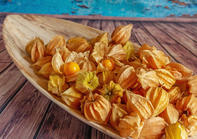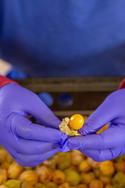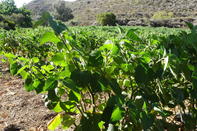The Cape Gooseberry, called “appelliefie” in Afrikaans, derives its name from its husk-like cape and not because it has any link to Cape Town in South Africa.

The golden berries originated in Peru, from where it spread to Columbia and subsequently to the rest of the world. It has been used as food and for medicinal purposes since the ancient Incan empire.
The species should not be confused with the English Gooseberry, which is a different species with no cape and is red, green or yellow. The cape gooseberry, as a matter of fact, is not a gooseberry at all, but part of the nightshade family of which tomatoes, peppers and potatoes are also members.
International Production
Columbia has been dominating the international market for many years, accounting for over 99% of all exports. William Pulles, the owner of the largest cape gooseberry farm: Keisie Valley Gooseberries, and supplier in South Africa, explains that production costs are so low in these South American countries, that other countries simply cannot compete.
The berries are produced on small-scale farms in Columbia. These farms typically measure two to five hectares each, with family members doing most of the work themselves, which results in hardly any labour costs. Once harvested, the berries are bought up by big companies that process the berries and export them to various destinations across the world.
Cape Gooseberries Local Production

Cape Gooseberries were introduced into South Africa during the 1770s along with the first immigrants.
It is produced throughout South Africa. The Western Cape is the largest producer of cape gooseberries followed by the North West. The shrub grows up to a metre high, thrives in regions with semi- to semi-arid climatic conditions, as found in Columbia and Peru. Cape gooseberries are best suited to environments that have warmth all-year-round with no temperature extremes and these ‘berries’ are highly sensitive to frost damage.
The shrub is able to thrive in a variety of soils, but the soil must have good drainage and high organic content. While cape gooseberries do not require lots of water, irrigation is needed for optimal production.
Cape Gooseberries Production Season
Cape gooseberries start bearing fruit between four to five months after being planted. The shrubs are then harvested weekly for up to eighteen months after which, it yields start to decline and the plants' have to be replaced with new seedlings.
Harvesting is done by hand since the berries have to be picked at optimal ripeness. The berries stop ripening, from a taste perspective, after they have been picked. Unripe picked berries may turn golden, but will not taste as good as berries that were picked at the correct ripeness.
Cape Gooseberry Varieties

Only one variety is produced, namely Physalis peruviana. To borrow William Pulles’ analogy, Cape Gooseberries are like the stepchild of the berry family, with limited investments in the development of new improved cultivars. Most producers also plant from seedlings as these are much cheaper than cuttings.
William gathers the seeds from his best plants, which he then shares with other suppliers. Specialised nurseries grow the seeds into seedlings for these producers.
Sales
The demand for cape gooseberries has been growing internationally due to increased awareness of their health benefits. William Pulles’ pointed out that Nestle has recently bought one of the biggest gooseberry companies in Columbia because they have earmarked gooseberries as the next big thing in the superfood market.
All of South Africa’s cape gooseberries are sold locally, with most of the fruit being diverted to the fresh market. The market, however, is limited because berries are expensive. Of the berries destined for the process market, most is used for making jams or cooked up into mixes used in fruit yoghurt.
Cape Gooseberries Uses
Cape gooseberries, unlike most other berries, have high levels of fat, making them carriers of fat-soluble vitamins such as A, D, E and K. Besides this, the berries are rich in minerals, protein, fibre, and antioxidants.
Cape gooseberries may be enjoyed fresh, used in baked goods, frozen or processed to be used in desserts, juices, yoghurts and jams. The berries and or leaves are claimed to have anti-inflammatory properties, ease digestion, promote weight loss and help to control diabetes as well as high blood pressure.
Medical Disclaimer
Information is for educational and informational purposes only and may not be construed as medical advice. The information is not intended to replace medical advice or treatment offered by healthcare professionals.